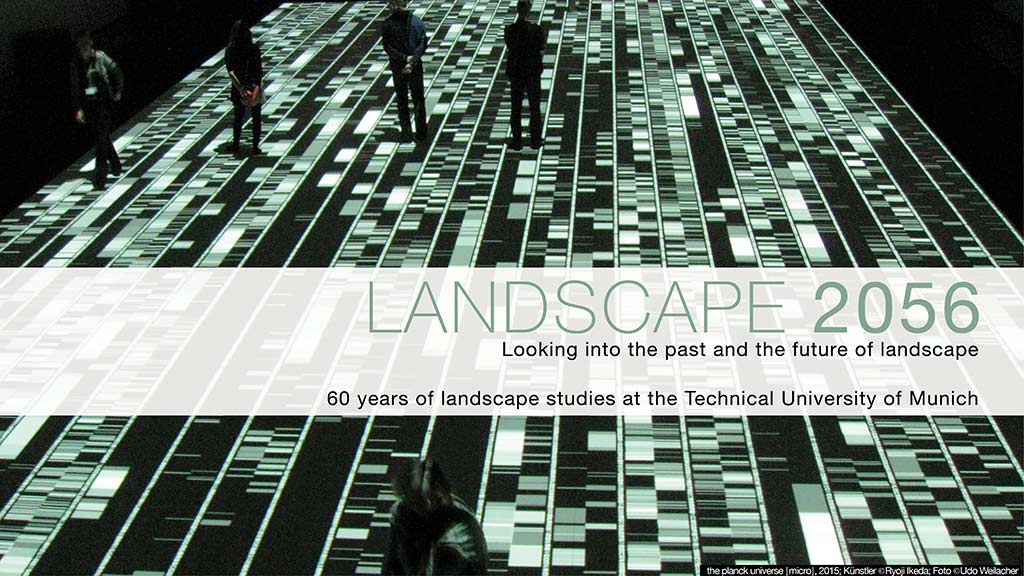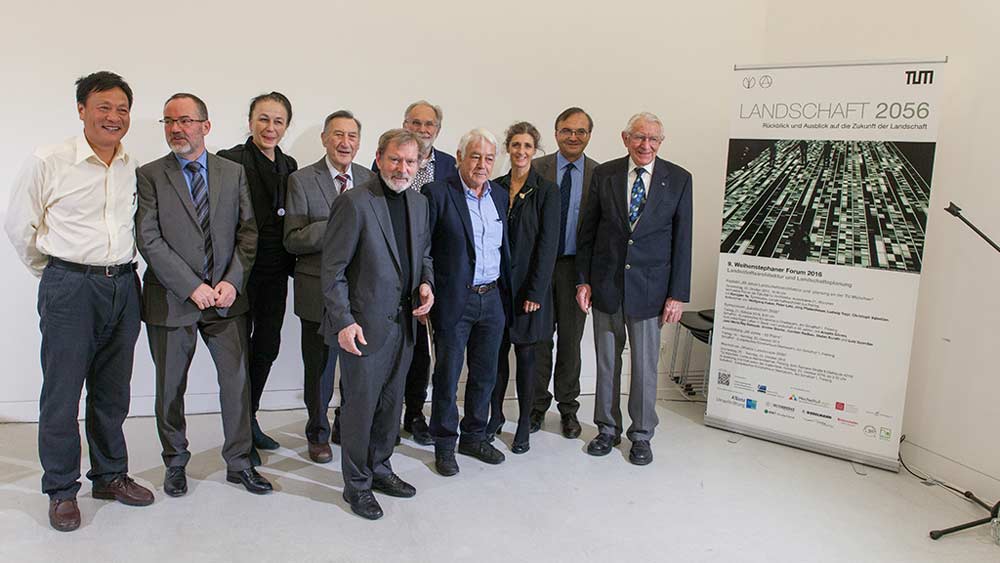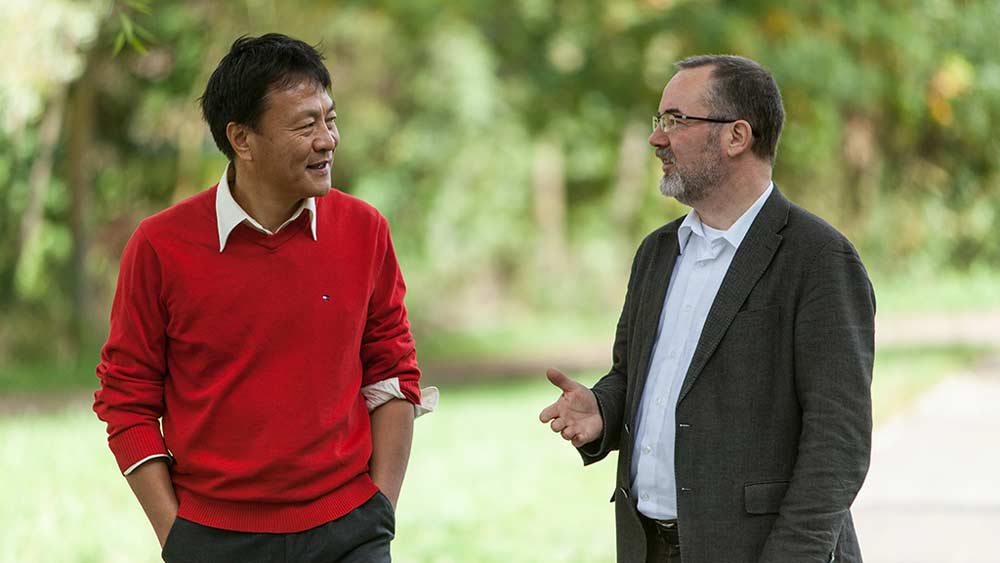Landscape and the art of survival

Event poster “LANDSCAPE 2056“; Technichal University of Munich, Landscape Architecture and Planning; © artist: Ryoji Ikeda; the planck universe, 2015; © photo: Udo Weilacher
This year marked the 60th anniversary of the Landscape Architecture and Planning program at the Technical University of Munich (TUM). It was celebrated with a ceremony and a symposium, each of them attended by 300 guests, an international workshop with 80 participants and an exhibition highlighting the work from the past 60 years.
TUM’s program was originally formed during the post WWII rebuilding efforts, at a time when landscape architects were in urgent demand. Meanwhile, it advanced to one of the most well-respected academic programs in landscape architecture and planning worldwide. Today, landscape architects must face new challenges to which the academic programs need to adapt. Renown guests from various disciplines each delivered a vision of the future of landscape and its impact on the profession. The event was highlighted by a speech given by Kongjian Yu, founder of Turenscape and Professor and Dean of the College of Architecture and Landscape Architecture at Peking University, who emphasized the excellent reputation of the TUM program and the relevance of the discipline.
The quest for a new terminology
The discussion about the future of landscape is inextricably interlinked with the terminology used in its description. The relationship between the rural and the urban is becoming increasingly blurred. Consequently, Kongjian Yu explained, the agricultural landscape traditionally associated with hard work, became a place of leisure in the urban context that led to a transformation of aesthetics. In general, traditional terminology associated with the aesthetic and romantic components of landscape will have to be modified. “We must scrutinize how we fundamentally categorize landscape” Undine Gieseke (TU Berlin) demands a new vocabulary to describe the rural urban nexus. While this is comprehensible, her declaration of “the end of landscape” and the introduction of hyper-objects as formulated by philosopher Timothy Morton seem to be little helpful. The swiss architect Stefan Kurath went even further by provokingly claiming that “landscape doesn’t exist and never has existed”. Unfortunately, the discussion about a new vocabulary got lost in abstract ideas.
Landscape architects must expand into new fields to stay relevant
One approach of gaining a more comprehensive understanding of the world is to process big data. According to Gieseke, however, we need to apply big data to concrete projects rather than just feeding them into models, thus making science become transformative. Lutz Spandau, CEO of the Allianz Umweltstiftung, suggested “to change our thinking patterns and to discover landscape in new ways” based on social, therapeutic, personality-oriented and education-focused aspects. Further, the recent tendency of implementing productive agricultural land into the urban fabric and the arising digital society will shape our cities in new ways. Landscape architects need to be prepared to fill these gaps of expertise.

TUM hosts and guests at the ceremonial celebration: Kongjian Yu (guest speaker), Udo Weilacher (TUM Chair for Landscape Architecture and industrial Landscape), Hannelore Deubzer (TUM Dean of the Faculty of Architecture), Christian Stern (class of 1956); Peter Latz, Jörg Pfadenhauer and Christoph Valentien (emeriti professors); Regine Keller (TUM Chair for Landscape Architecture and Public Space), Gerhard Müller (TUM Vice-President), Wolfgang Haber (emeritus professor); © Sonja Weber
Landscape architects must get more political
Wolfgang Haber, Christoph Valentien, Jörg Pfadenhauer and Peter Latz, four emeriti professors who have actively shaped the development of the profession, expressed their unanimous concern over the little influence of landscape architects and planners due to a lack of political involvement. They must overcome the passivity of the last decades and become active. While this dilemma can be observed worldwide, Kongjian Yu may stand out as a role model and proof that a political landscape architect can make a big difference.
Landscape architects must want the ordinary
Current design trends were also criticized. There is an “aesthetics of the ordinary” that is missing that would create solutions that are “less but better” (Valentien). “We must want the ordinary and achieving the ordinary is extremely hard. When everyone creates the outstanding then this will result in chaos.” states landscape architect Peter Latz. Inspired by Latz and the ecologist Haber, Kongjian Yu asks to “value the ordinary” and to “minimize intervention and maximize output”.

Udo Weilacher and Kongjian Yu exchange views on a stroll through the campus gardens; © Sonja Weber
Landscape architects must read the landscape
Single-minded engineering solutions are not sustainable. Alternatively, as Kongjian Yu explains, green solutions need to be applied in order to establish an ecological infrastructure: “We need to read the landscape and create deep forms that create a strong relationship between the manmade landscape and ecological processes”. Yu defines landscape architecture as “an art of survival” that successfully handles environmental challenges through planning, design, engineering, and management.
Landscape architects must create a hyper-faculty for landscape
Interdisciplinary collaborations are already a common procedure in the professional world yet need to be improved and further developed. The academic world should likewise create better networks and form alliances. If small landscape architecture schools want to be able to compete in the global academic market, they need to organize themselves in order to generate the vast knowledge that will be needed. Alone they will struggle to answer the questions about the future. Gieseke therefore suggests a hyper-faculty for landscape.
TUM’s landscape architecture program has historically had an excellent reputation for training young professionals. The holistic education, the multidisciplinary, project-based training and the mandatory international experience have made this program unique. The success of the program has been proven by a high demand for graduates in the professional world. Udo Weilacher said that the department wanted “to achieve more” however, they “are driving with a tightened hand break”. It is hoped that funding levels will be provided to allow the program to progress in a way that will meet the challenges which the field is beginning to face.
For those who are interested in the entirety of the presentations, including Kongjian Yu’s lecture, visiting the website of the Study Program Division Landscape Architecture and Landscape Planning at Technical University of Munich is recommended: www.landschaft.wzw.tum.de.
From: LANDEZINE
The original link: http://www.landezine.com/index.php/2016/11/landscape-and-the-art-of-survival/
